
Art Gharana — 12 Mins read
Complete Guitar Strings Guide (Electric & Acoustic)
Musical Instruments
 Guitar strings are the lifeline of every guitar, shaping the tone, feel, and playability of the instrument. Choosing the right strings can be confusing, but understanding guitar string types, materials, and gauges will make it simpler. This complete guitar strings guide will help you learn how to choose guitar strings, understand guitar string maintenance, and find the best guitar strings for beginners or pros.
Guitar strings are the lifeline of every guitar, shaping the tone, feel, and playability of the instrument. Choosing the right strings can be confusing, but understanding guitar string types, materials, and gauges will make it simpler. This complete guitar strings guide will help you learn how to choose guitar strings, understand guitar string maintenance, and find the best guitar strings for beginners or pros.
Whether you play electric guitar strings or acoustic guitar strings, the right selection impacts your sound and comfort. String tension, guitar finger strength, and playing style all affect your choice. By the end of this guide, you’ll know exactly how to pick, maintain, and replace your guitar strings to achieve the perfect tone.
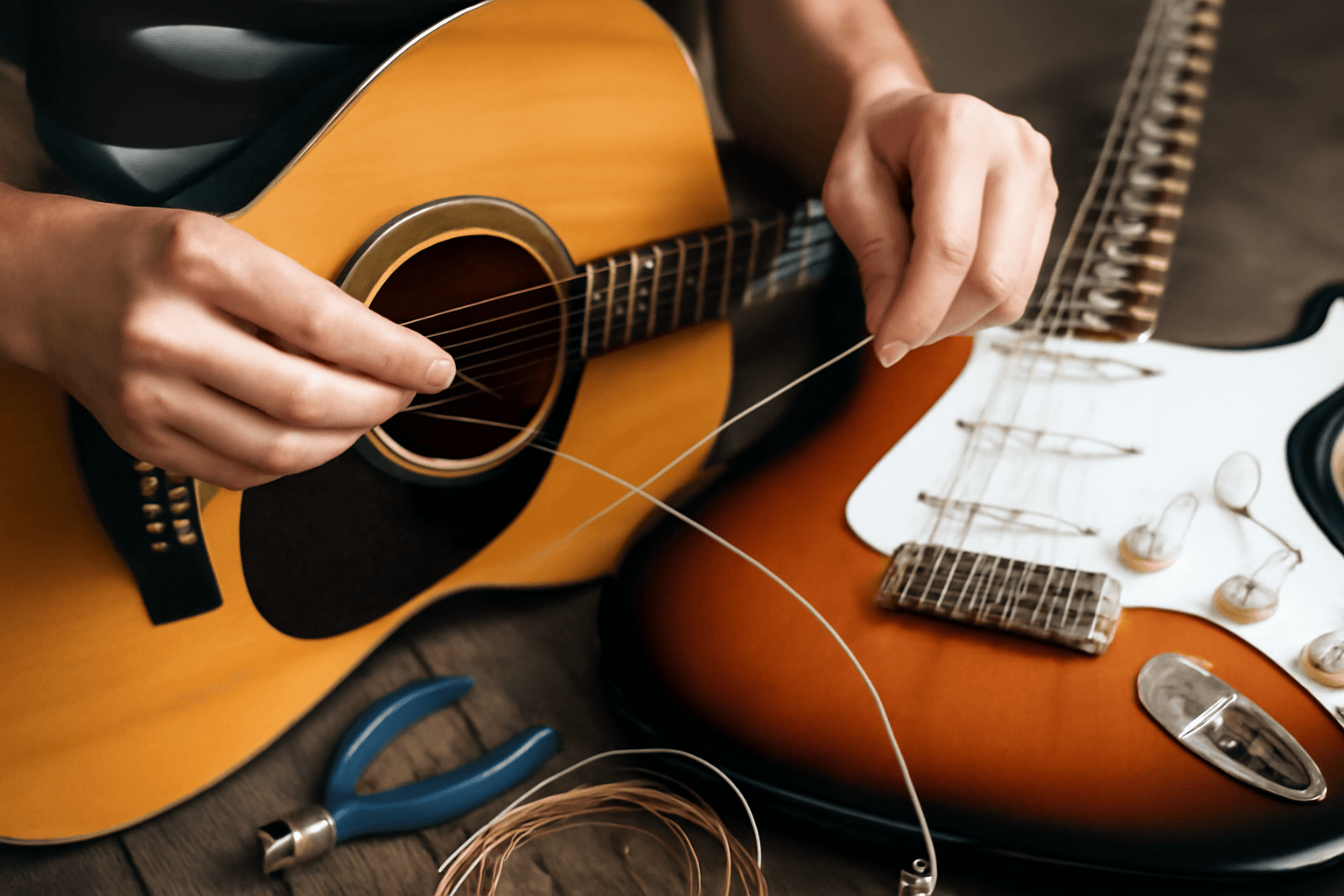
Guitar strings influence every note you play, from bright melodies to deep chords. The material, thickness, and winding method of a string determine your guitar tone and playability. String tension affects how easy it is to bend notes and howf comfortable your fingers feel during long sessions. Strings that match your playing style make a huge difference in both lead and rhythm performance.
Changing strings regularly also ensures your guitar sounds fresh and clear. Guitar string longevity depends on your frequency of play, sweat, humidity, and string materials. Neglecting old strings can make your guitar sound dull and intonation unstable. Proper guitar string care improves tone and prolongs the life of both acoustic and electric guitar strings.
Electric guitar strings are usually thinner and brighter. Most electric guitars use nickel-plated strings for clarity, sustain, and a smooth feel. Acoustic guitar strings, on the other hand, rely heavily on the body resonance, so materials like phosphor bronze strings or 80/20 bronze are preferred. The choice of acoustic strings directly impacts volume, tone, and projection.
Electric guitar strings are easier on fingers and are suited for bending notes, vibrato, and solos. Acoustic guitar strings require more finger strength, especially medium or heavy gauges, but they produce a fuller, richer sound. Knowing the difference helps you choose strings that match your style and genre, whether you play jazz, rock, blues, or folk.
Strings shape your tone by their material, gauge, and winding. Roundwound guitar strings produce bright, crisp tones, while flatwound guitar strings are smooth and mellow, often used in jazz. The thickness of the strings, measured as light, medium, or heavy strings, changes playability and sustain.
Playing style also affects string selection. Fingerstyle players may prefer softer tension and nylon strings, whereas rock guitarists often select heavier gauges for a strong attack. The combination of string type, tension, and guitar body defines your unique sound, so experimenting with different strings is essential for tone perfection.
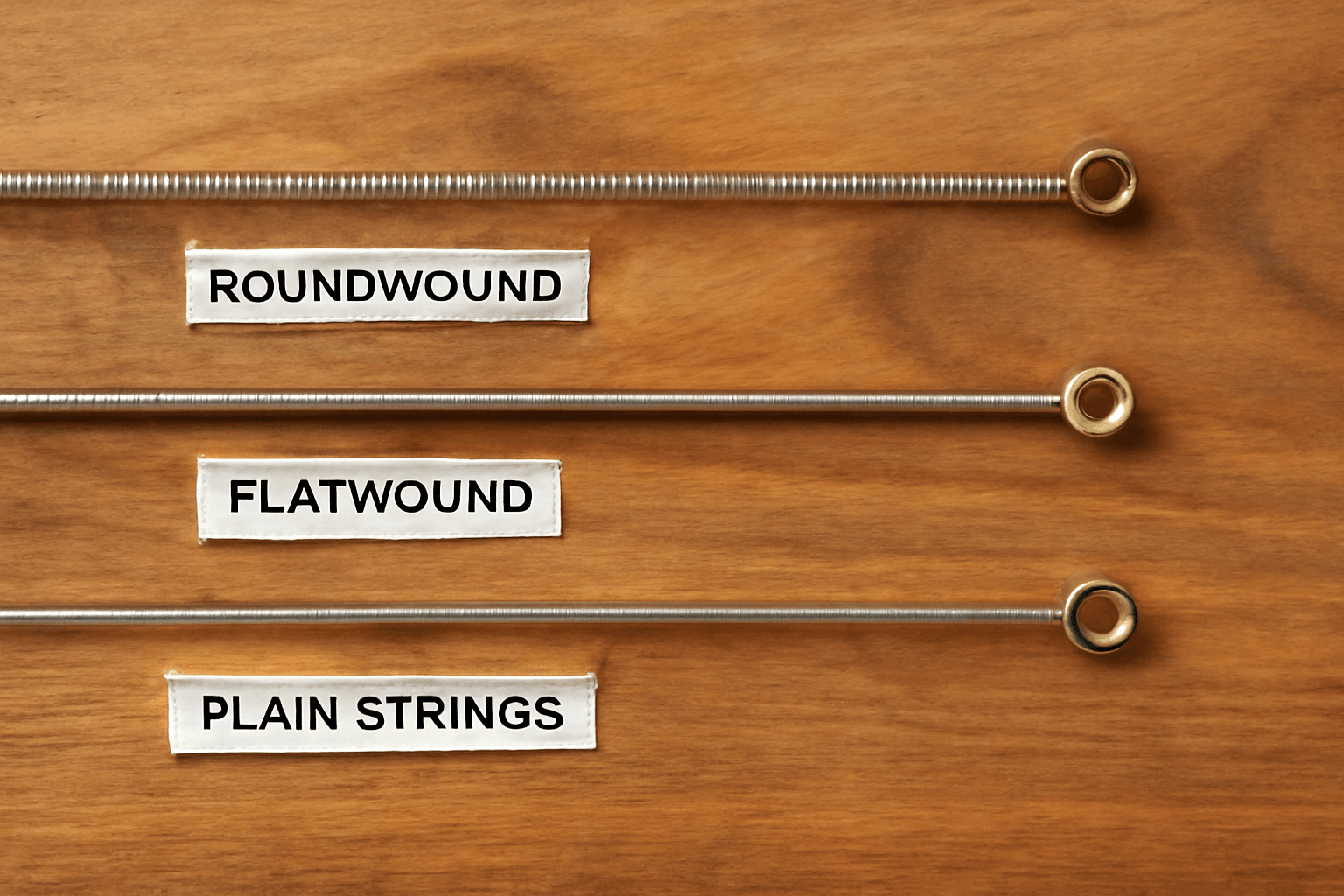
Roundwound strings are the most common type, with a round wire wrapped around the core. They offer bright, articulate tones and excellent sustain. Most electric and acoustic guitars use roundwound strings for their balanced tone and versatility across genres.
These strings are ideal for lead playing and dynamic strumming. They also respond well to altered guitar tunings. Roundwound strings may wear faster, but proper guitar string care can extend their life significantly.
Flatwound strings have a smooth, flat surface that produces warm, mellow tones. They reduce string squeak during slides, making them perfect for jazz, blues, and clean fingerstyle playing. While less common, they offer a unique tone that stands out in recordings.
Flatwound strings are slightly heavier and require more finger strength to bend, which makes them suitable for controlled, precise playing. Guitar string replacement frequency depends on play style, but flatwound strings often last longer than uncoated roundwound strings.
Plain strings are typically used for high notes on both electric and acoustic guitars. They consist of a single steel or nylon wire without winding. These strings allow smooth bends, clear melodies, and expressive solos.
Plain strings are used not only on guitars but also on banjos and mandolins. They are essential for producing bright, focused tones and are often combined with wound strings to complete a guitar string set.
Coated guitar strings have a polymer layer that protects against sweat, dirt, and corrosion, improving longevity. Uncoated strings provide a traditional feel and natural tone but may wear faster, especially in humid UK climates.
Choosing coated or uncoated strings depends on your playing frequency and preference for tone versus durability. Coated strings are ideal for guitarists who want guitar string longevity without frequent replacements.

Nickel-plated steel strings are bright, durable, and widely used on electric guitars. They combine steel’s brightness with nickel’s warmth, offering balanced tone and smooth playability.
These strings handle bends, vibrato, and aggressive picking well, making them ideal for UK rock and pop musicians. Their moderate string tension provides comfort without sacrificing tone.
Stainless steel strings resist corrosion, offering a sharper tone and longer life. They are slightly harder on the fingers but deliver excellent clarity and sustain.
These strings are perfect for heavy strumming and high-volume performances. Regular guitar string maintenance ensures stainless steel strings stay bright and balanced.
Pure nickel strings are softer and warmer, giving a vintage tone reminiscent of classic blues and jazz. They produce smooth, mellow sound, perfect for subtle fingerstyle or clean electric tones.
Although they may lack the brightness of nickel-plated steel, their warmth enhances tonal depth. UK players often choose pure nickel for recordings that require smooth, balanced guitar tone.
Acoustic guitars benefit from bronze and phosphor bronze strings, which deliver rich, bell-like resonance. Phosphor bronze offers slightly warmer tones and better corrosion resistance than standard bronze.
These strings are standard for acoustic guitarists in the UK. They balance projection, sustain, and finger comfort, making them suitable for folk, country, and contemporary acoustic music.
Silk and steel strings combine a steel core with silk winding, producing a soft, mellow tone. They reduce string tension and are easier on fingers, ideal for fingerstyle and delicate acoustic playing.
These strings highlight subtleties in chord voicing and note articulation, providing smooth playability without harsh overtones.
Nylon guitar strings provide warm tones, lower tension, and finger comfort, making them ideal for beginners. Classical guitarists often pair nylon for treble strings with silver-plated copper for bass strings.
Nylon strings excel in classical, flamenco, and fingerstyle genres. Their reduced tension protects the guitar neck and enhances sustained, expressive tones.
Polymer coatings protect strings from sweat, dirt, and corrosion. Treated strings maintain bright tone longer and extend the life of electric guitar strings and acoustic guitar strings.
Proper care, such as wiping strings after play and storing them correctly, maximizes lifespan. Coated strings also reduce finger wear while preserving tone.
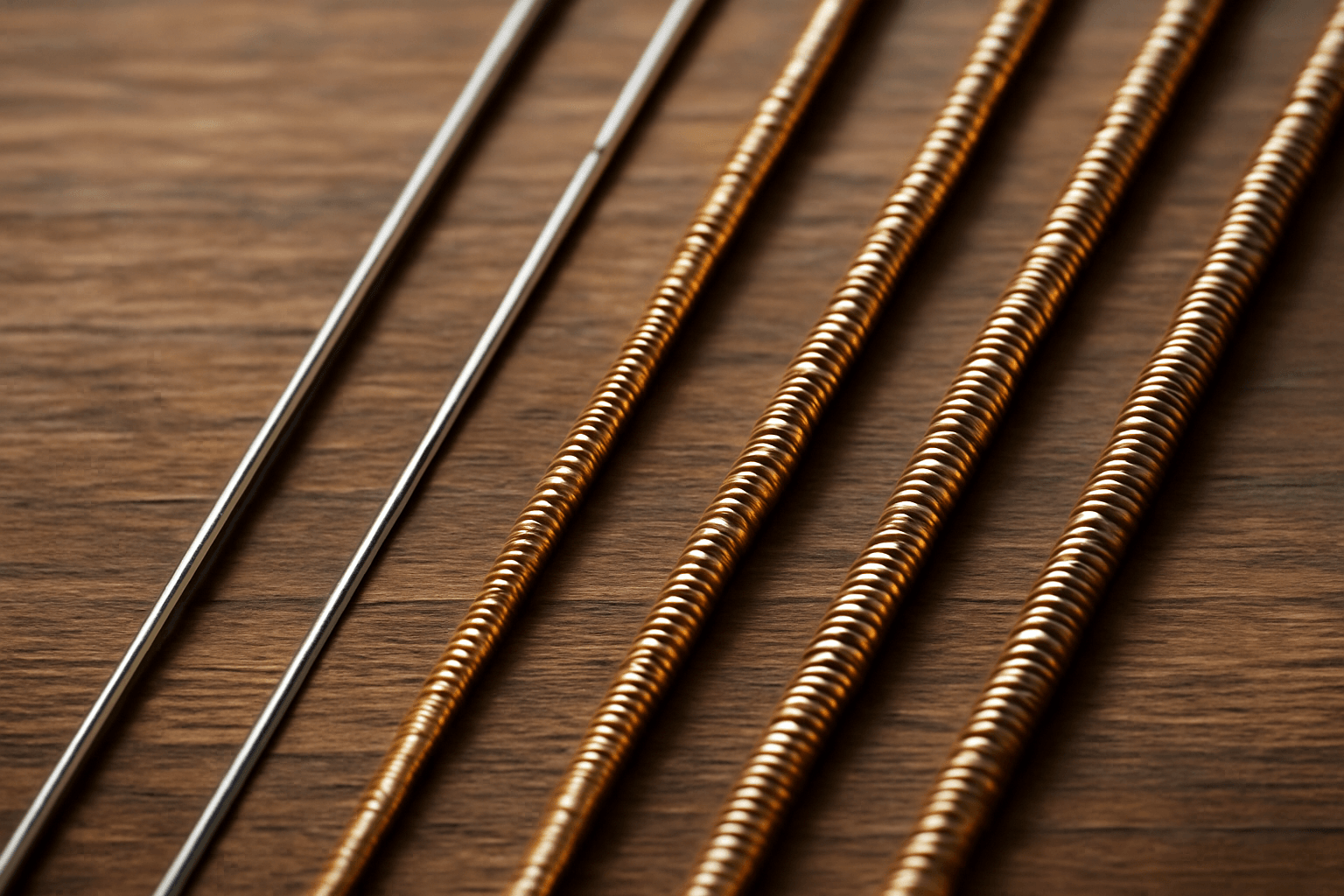
String gauge refers to thickness, affecting tension, tone, and playability. Lighter strings are easier to bend and suitable for beginners, whereas heavier strings provide fuller tone and better sustain.
Gauge selection also affects guitar finger strength requirements. Guitarists often experiment to balance comfort, tone, and performance style.
Light strings (9-42) are easy on fingers, medium (10-46) balances tone and playability, and heavy (11-56) provides tension for strong attack. Acoustic players often choose slightly heavier gauges for richer resonance.
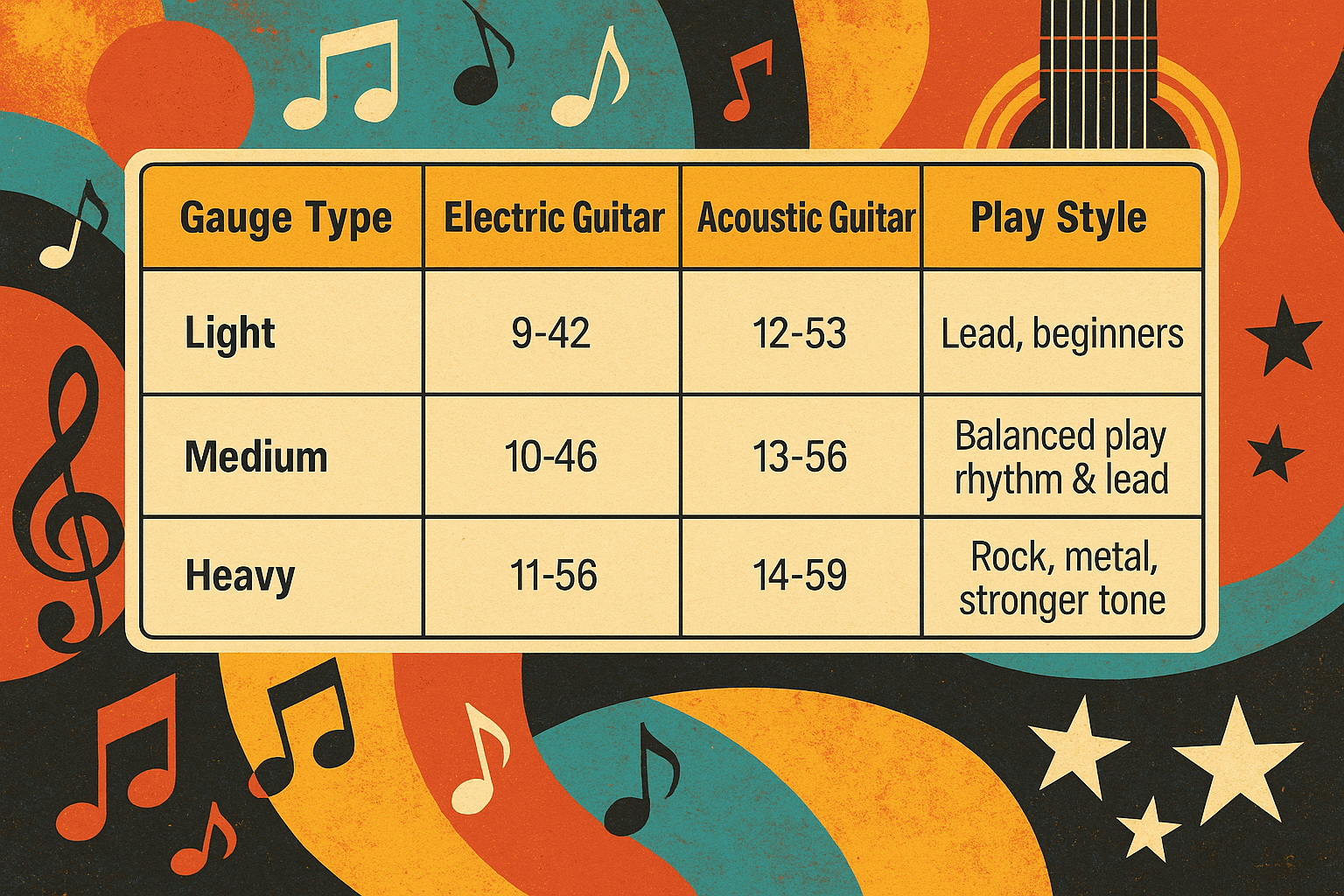
Thicker strings produce a fuller, louder tone but require more finger strength. Lighter strings are flexible, great for bending and fast playing. Gauge choice also affects tuning stability and altered guitar tunings, especially on extended-range guitars.
Beginners should use light strings to build comfort. Intermediate players often prefer medium gauges for versatility. Professionals may choose specific gauges for genre-focused tone and precise guitar tone and playability.
Electric guitar strings are designed for clarity, sustain, and responsiveness. Nickel-plated strings are most common, offering a bright tone with smooth bends. Stainless steel strings provide sharper, more articulate sounds, while pure nickel strings create vintage warmth ideal for blues and jazz.
String tension affects your ability to bend notes and execute fast solos. Choosing the right gauge, winding method, and material ensures optimal guitar tone and playability for lead, rhythm, or hybrid styles.
Light gauges (9-42) suit beginners and fast lead players, while medium (10-46) balances rhythm and solo work. Heavy gauges (11-56) suit metal and rock styles requiring tight string tension and stronger tone. Roundwound strings are standard, but flatwound strings provide a smoother, mellow sound for jazz or blues.
Popular UK electric brands like Ernie Ball, D’Addario, and Elixir offer consistent quality and durability. Coated guitar strings extend guitar string longevity and maintain brightness over weeks of play.
Ernie Ball Regular Slinky and Elixir Nanoweb are widely praised for tone, durability, and feel. D’Addario XL strings are versatile for different genres. Choosing high-quality strings ensures consistent sound, fewer breaks, and improved guitar string care results.

Acoustic guitar strings emphasize resonance and projection. Materials like phosphor bronze strings enhance tone, while roundwound strings provide brightness and sustain. Acoustic strings are thicker and require more finger strength, especially on medium or heavy gauges.
Unlike electric guitars, acoustic strings rely on body vibration for tone. Proper guitar string replacement frequency ensures that your chords and fingerpicking patterns sound clear and balanced.
80/20 bronze strings produce a bright, crisp sound but corrode faster, while phosphor bronze strings are warmer and longer-lasting. Silk and steel strings soften tension, ideal for fingerstyle and gentle strumming. Coated strings protect against sweat and moisture common in UK climates.
Acoustic guitar strings usually last 2-3 months or 100 hours of play. Frequent players, performers, and recording artists may replace strings weekly. Factors like humidity, sweat, and genre influence guitar string longevity.
Strings that sound dull, show corrosion, have lost tension, or feel rough indicate replacement. Broken strings or difficulty holding tuning are also clear signs. Observing these signs you need new guitar strings keeps tone fresh and playability smooth.
Fingerstyle guitarists often choose silk and steel or light phosphor bronze strings. Folk and country players prefer medium gauges for balanced resonance, while strummers may select heavy strings for strong projection. Matching strings to genre ensures optimal guitar tone and playability.

Nylon strings are softer, easier on fingers, and provide a warm, mellow tone. They pair well with classical, flamenco, and fingerstyle techniques. Lower tension protects guitar necks while maintaining expressive guitar tone and playability.
12-string guitars pair octaves or unison strings for a jangly, rich tone, while baritone guitars use heavier strings for lower tunings. Bass guitars and 7- or 8-string extended-range guitars require specialized string gauges to handle tension without sacrificing clarity.
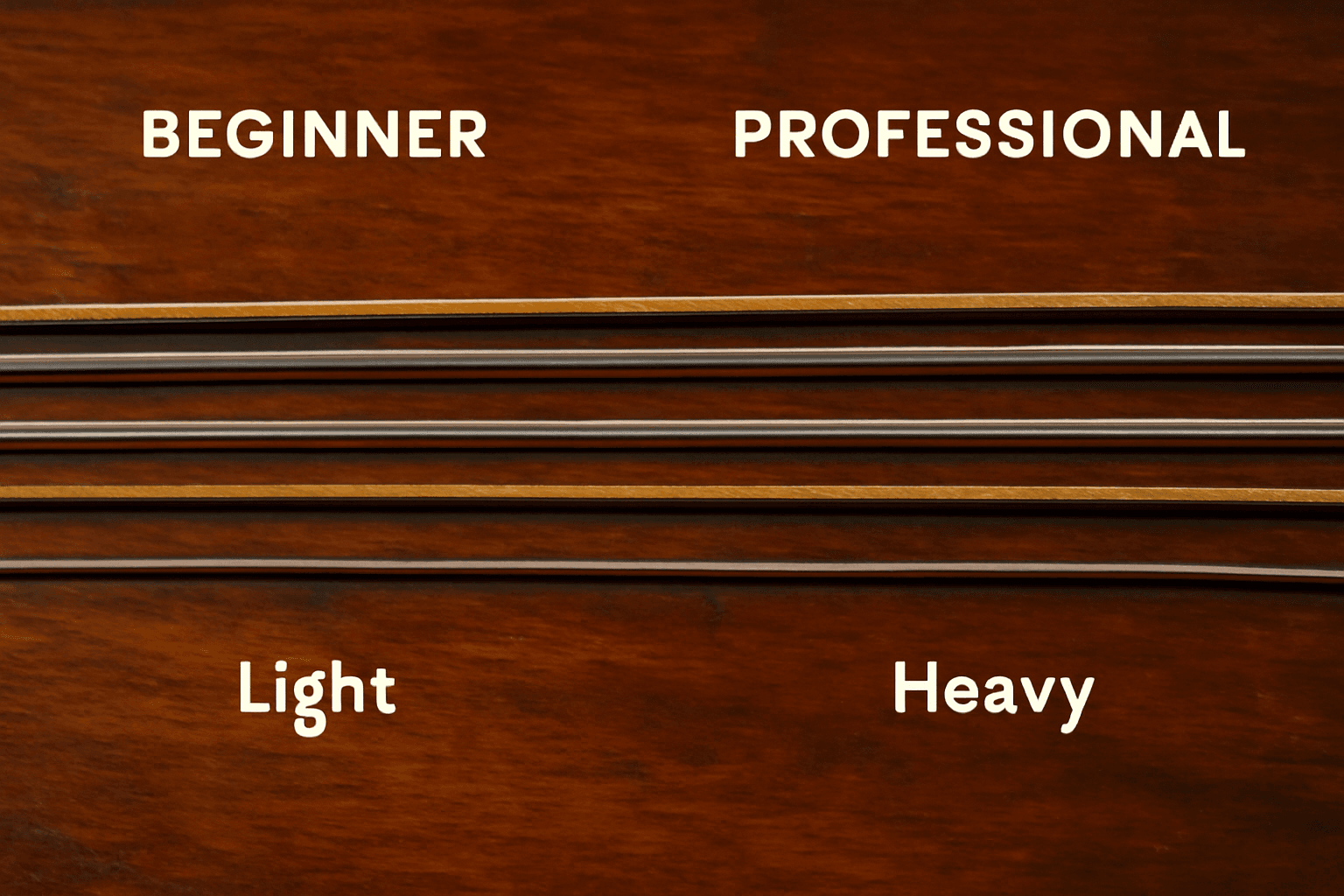
Guitar type determines string material. Classical guitars need nylon, electric guitars thrive on nickel-plated steel, and acoustic guitars perform best with bronze or phosphor bronze strings. Correct material ensures proper guitar tone and playability.
Bright tones suit lead playing, folk, and pop genres, while warm tones enhance jazz, blues, and fingerstyle. Material and winding methods, such as roundwound for brightness or flatwound for warmth, influence the sound significantly.
Strummers may prefer medium to heavy gauges for volume and sustain, while fingerpickers benefit from lighter strings. Altered tunings may require heavier strings to maintain string tension and avoid slack.
Comfort depends on gauge, winding, and material. Light gauges reduce finger fatigue and are ideal for beginners, while heavier gauges offer better control for advanced techniques. Proper guitar string care improves tactile response and reduces finger wear.
Beginners should start with light gauge, nickel-plated electric, or phosphor bronze acoustic strings. Intermediate players explore medium gauges for versatility, and professionals may choose specialized strings for tone precision, guitar string durability, and specific genre requirements.
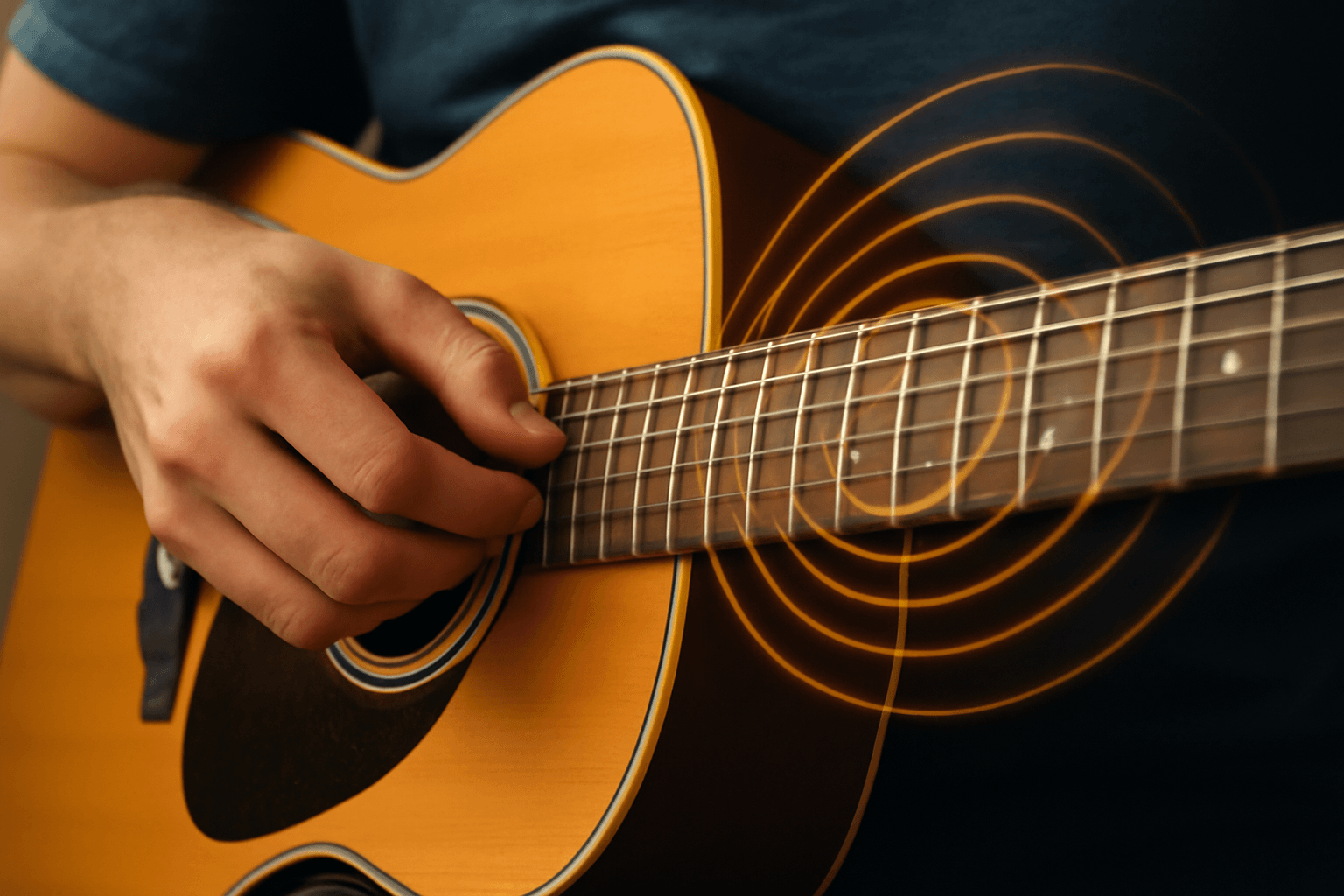
Most guitars have six strings, tuned E-A-D-G-B-e. Standard tuning allows easy chord formation and versatile playing. Guitar string replacement frequency is essential to maintain consistent tone and sustain.
Extended-range guitars add lower strings for metal, jazz, and progressive styles. 12-strings pair strings in octaves or unison for fuller sound. Gauge selection is crucial to maintain string tension and tuning stability.
Alternative tunings, drop tunings, and specialized string setups enable unique sounds for metal, rock, jazz, and folk genres. Matching guitar strings for different music genres optimizes tone and playability.

Gauge affects comfort, tone, and playability. Lighter strings are easier for beginners, medium strings offer versatility, and heavy strings provide strength and sustain.
Roundwound strings are bright, flatwound strings are mellow, and halfround strings balance both. Winding affects feel, tone, and friction noise during slides.
Choose material and coating based on guitar type, playing style, and guitar string longevity. Coated strings resist corrosion and extend life, while uncoated strings provide traditional feel and tone.
Frequent players may invest in premium strings to reduce replacement frequency. Budget strings work for casual play but may sacrifice tone and lifespan.
Remove old strings one at a time, secure new strings in the bridge and tuning pegs, and slowly bring to tension. Stretch and tune each string gradually to avoid neck strain.
Use a tuner for precise pitch. Tune strings slowly and recheck after stretching. Alternate tunings may require heavier gauges to maintain string tension.
String winder, wire cutters, tuner, and neck rest simplify restringing. Proper tools prevent damage and make the process efficient.

Wipe strings after each session, store in a dry case, and avoid touching with oily hands. Coated strings stay bright longer.
Use microfiber cloths, string cleaners, and humidity control. Proper storage reduces corrosion and maintains tone.
Over-tightening, leaving dirt, or improper winding leads to breakage and dull tone. Regular replacement ensures consistent sound.
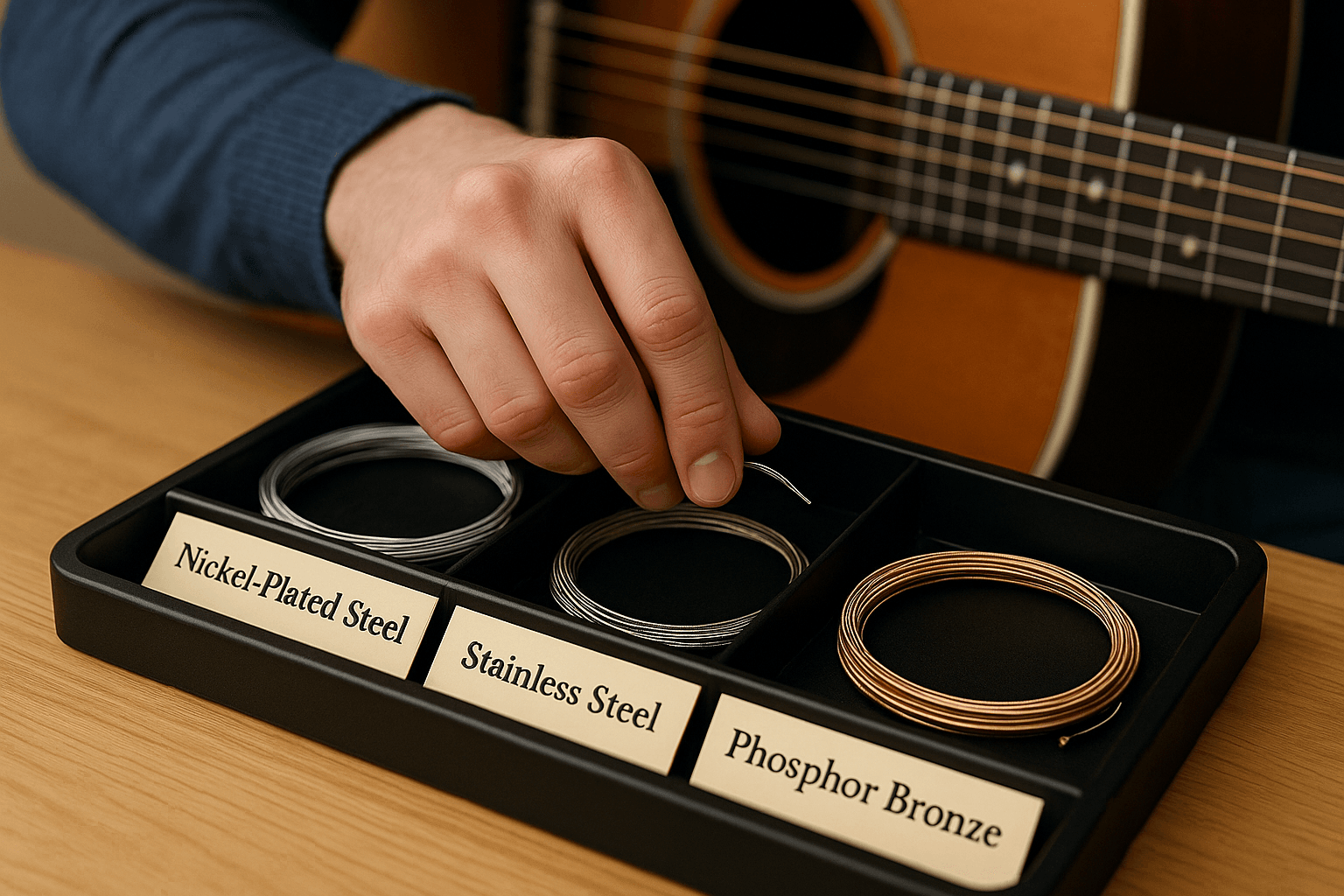
Choose strings based on desired brightness, warmth, and genre requirements. Tone directly affects style and musical expression.
Gauge and material influence finger fatigue, bends, and speed. Comfortable strings improve practice and performance.
Coated strings last longer, resist corrosion, and reduce frequent guitar string replacement.
Different genres demand varied strings. Jazz prefers flatwound, rock prefers medium/heavy roundwound, and classical uses nylon.
Every 2-3 months or 100 hours of play, depending on use, moisture, and sweat.
Yes, but ensure balanced tension for tuning stability and tone.
Coated strings last longer and resist corrosion, uncoated strings offer natural tone.
High-quality strings provide better tone, durability, and consistent feel, though personal preference matters.
Wipe strings, avoid moisture, and store guitars properly. Coated strings reduce wear and maintain brightness.
Consider guitar type, gauge, material, and genre. Experimentation ensures the best combination for tone, playability, and comfort.
Proper string selection improves guitar tone and playability, increases longevity, and enhances musical expression. Understanding gauge, material, and winding methods helps beginners and pros alike achieve the perfect sound. Regular care and timely guitar string replacement maintain peak performance.